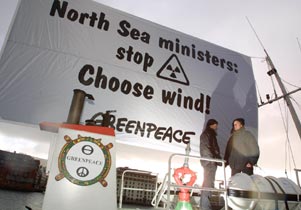
Choose Positive Energy petition hand in
Greenpeace and The Body Shop presented 1,602,489 signatures to the Earth Summit in the form of an interactive mural calling upon delegates to agree to get clean, reliable, renewable energy into the hands of 2 billion of the world's poorest people by 2010.
Greenpeace and The Body Shop teamed up about a year ago to create the Choose Positive Energy Campaign, launched in January of this year. The demand: that governments vastly expand renewable energy for people across the world - the industrialised governments should expand their renewable energy supplies and all governments should commit to providing small-scale renewable solutions like solar and wind power, small-scale hydro, and biomass, to the world's poorest.




